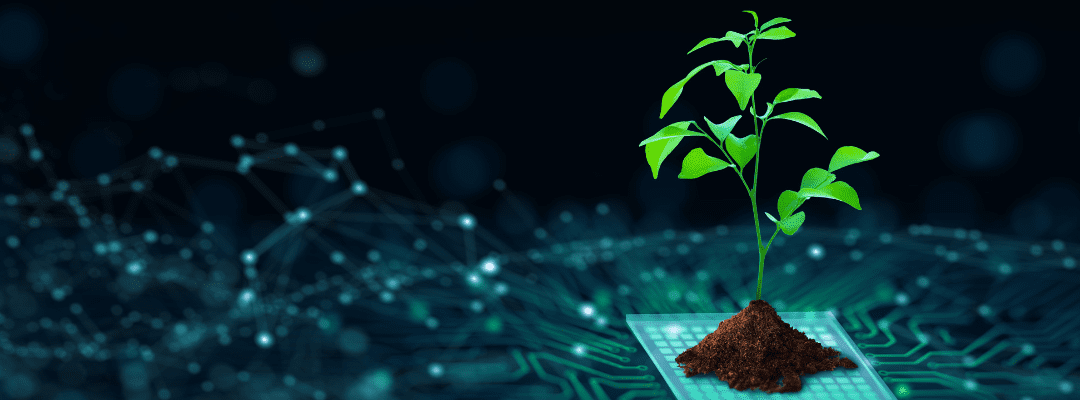With its ability to perform a range of everyday tasks, from reorganizing and classifying data to writing text and creating digital art, generative AI has dominated headlines for the past 12 months as the world works to understand how this technology can work to our advantage.
Generative AI adds value in several areas, but most often, in productivity – with reports predicting that it can increase the impact of all artificial intelligence by up to 40 percent. And, 75 percent of the value that generate AI will deliver focuses on four key areas: customer operations, sales and marketing, software engineering, and R&D.
Like many industries, these are critical areas of focus for agriscience. There’s potential for a great unlock here for the agricultural industry; but what does that mean? Does it pose an opportunity to truly transform the industry and drive innovation forward? Or, because of the unique challenges that agronomic leaders face, will it only open the door to risks that should be avoided?
Seed Breeding of the Future
From the development of hybrid crops to the adoption of high-yielding varieties during the Green Revolution, the growth in crop yields and agricultural productivity over the past 70 years is mostly due to a series of biological innovations in seeds.
Today’s global agricultural leaders spend a great deal of money on agricultural research and development to help propel the industry forward. In fact, the USDA’s Agricultural Research Service (ARS) has a budget of $1.89 billion this year alone.
But, what if generative AI in agriculture could play a role in augmenting seed breeding – propelling innovation ahead faster than we could ever imagine?
Generative AI can help to identify key genes that show specific traits that researchers are interested in, based on the qualities that are shown (e.g., more resistant to pests and diseases, or higher-producing seeds). And, it can be used to combine these traits together to determine what the end product would be.
Given the seasonal nature of agriculture, there are often delays in research cycles to accommodate for the growing season. But, what if generative AI in agriculture could transform this? What if it could remove some of the elements of seasonality? What would the impact be on innovation and for progressing our food system to where it needs to be to feed the world’s population in 10, 20 or 30 years?
Putting “Predict” in the Unpredictable
One of the biggest challenges that in agriculture comes from the site specificity of data. Even just fields away, different weather events (like hail storms), terrain, or even soil differences can completely alter the methods in which farmers have to optimize crop production.
In some ways, this has challenged innovation in the agronomic space. Localized data provides more specific insights into what’s happening in the field, and this specificity is required to understand what the best methods may be needed to optimize crop health. To make it more challenging, this data may even be constrained by time limits – and not relevant season over season.
With generative AI, there is an opportunity to transform how data is leveraged within a designated area. Leveraging what are called “digital twins,” researchers are beginning to use generative AI in agriculture to replicate physical systems into virtual representations of fields, farms, or even entire regions.
But, with digital twins, researchers can finally replicate these physical locations into a virtual environment by simulating the behavior of the system. This can be used to inform decisions on how to improve crop yields, or prevent crop losses.
This is where agronomic modeling can be particularly useful as well. By leveraging the data related back to the specific area in question, it can provide deep insight into what is happening in a particular area – helping to measure the timing of harvest readiness or even forecasting end-of-season yield outcomes.
Advancing Outcomes by Optimizing Crop Production
Today’s growers face a number of challenges that continue to squeeze yields. Weeds are one of the areas that continue to pose challenges, especially as we face growing herbicide-resistance and new growth patterns due to the changing climate.
Reports show that crop yields can be reduced up to 34 percent because of weeds. But, with that comes the challenge of meeting more stringent regulations for applying herbicides (even with some in-season deadlines for some chemistries) while finding solutions to alleviate environmental concerns.
This is where generative AI in agriculture can really shine.
Imagine being able to detect weeds at a smaller size without sacrificing precision. This is detected via aerial imagery captured by a drone, and run through an advanced data science ecosystem to generate a prescription that can then be run in a sprayer to reduce the amount of herbicide that is sprayed, focusing only on the areas where the weeds are detected. In doing so, it can significantly reduce the amount of herbicide used – reducing the off-target movement while resulting in huge savings for the grower.
Building this advanced data science ecosystem can be challenging. While weeds are more prevalent given the weather conditions, to tune an advanced data science ecosystem to that degree requires a significant amount of imagery.
Sentera is changing the script. The company has patent-pending technology that leverages synthetic imagery to feed it’s machine learning platform, tuning and training the model to accurately detect weeds at a quarter inch with high accuracy. In turn, growers can get into the field and spray faster, so they can mitigate the impact it has on their yields (and spend their time focusing on one of the other things that need to get done!).
Synthetic data – specifically imagery – has been up for debate on whether it’s ethical and “good” for society. But, in this case, when used for agriculture to solve one of the toughest agronomic challenges that our society faces, it can transform how quickly – and accurately – this pest can be detected and treated. And, the good is undisputable – lowering the amount of herbicide that is applied in the field equates to a healthier environment.
Are We Ready for Generative AI in Agriculture?
These are just a few cases of how generative AI is being used in agriculture. From optimizing crop production to accelerating innovation, generative AI has proven that it has a home in agriculture.
Just like with the digital revolution that has been evolving agriculture over the past decade, the adoption of generative AI won’t completely change the industry over night. It will take time, and in many of these cases; it’s helping to save time and reduce the seasonality of the growing season – but it will still require the expertise and knowledge that so many in the industry bring to the table.
The future of generative AI in agriculture is bright – and for it to be successful, agriculture will continue to need the generations of great people that contribute, day in and day out, to the vital food infrastructure for our world.


